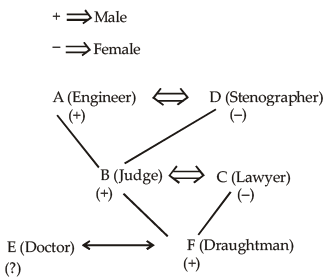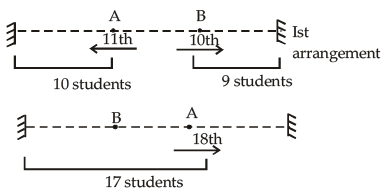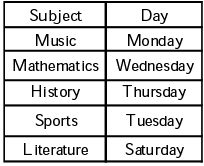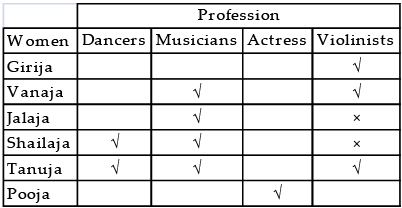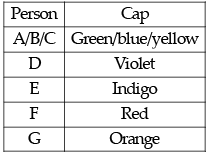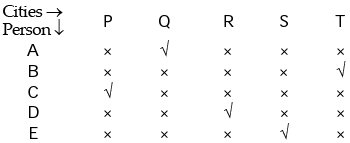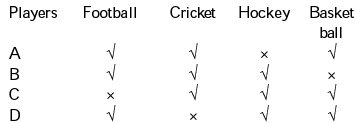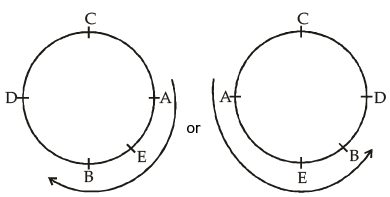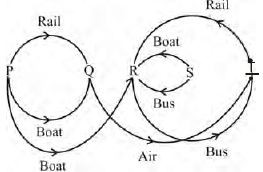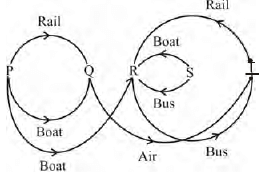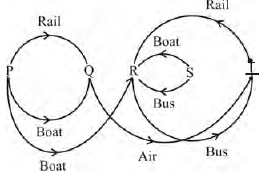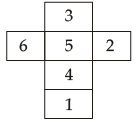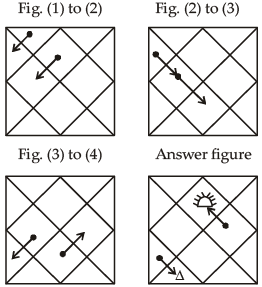Mental Ability, Analytical & Logical Reasoning- Solved Questions(1995-2020)- 5 - UPSC PDF Download
Question 1: DIRECTIONS: Read the passage given below and answer the items follow.
A, B, C, D, E, F are members of a family. They are engineer, stenographer, doctor, draughtsman, lawyer and judge (not in order). A, the engineer is married to the lady stenographer.
The judge is married to the lawyer. F, the draughtsman is the son of B and brother of E. C, the lawyer is the daughter-in-law of D. E is the unmarried doctor. D is the grandmother of F. There are two married couples in the family.
What is the profession of D? [2014 - II]
(a) Judge
(b) Stenographer
(c) Doctor
(d) Cannot be determined
Correct Answer is Option (b)
Stenographer
Question 2: If the 3rd day of a month is Monday, which one of the following will be the fifth day from 21st of this month? [2014 - II]
(a) Mon day
(b) Tuesday
(c) Wednesday
(d) Friday
Correct Answer is Option (b)
Tuesday
3rd ⇒ Monday + 7
10th ⇒ Monday + 7
17th ⇒ Monday + 7
24th ⇒ Monday
Fifth day from 21st is 25th day.
So, on 25th day is Tuesday.
Question 3: In a row 'A' is in the 11th position from the left and 'B' is in the 10th position from the right. If ‘A’ and ‘B’ interchange, then 'A' becomes 18th from the left. How many persons are there in the row other than 'A' and 'B'? [2014 - II]
(a) 27
(b) 26
(c) 25
(d) 24
Correct Answer is Option (c)
No. of students between A & B in the 1st arrangement = 17 – 11 = 6
∴ Total no. of students except A & B is, = 10 + 6 + 9 = 25
Question 4: Examine the following statements:
1. George attends Music classes on Monday.
2. He attends Mathematics classes on Wednesday.
3. His Literature classes are not on Friday.
4. He attends History classes on the day following the day of his Mathematics classes.
5. On Tuesday, he attends his sports classes.
If he attends just one subject in a day and his Sunday is free, then he is also free on [2014 - II]
(a) Monday
(b) Thursday
(c) Saturday
(d) Friday
Correct Answer is Option (d)
According to question,
So, Friday is free.
Question 5: Four persons, Alok, Bhupesh, Chander and Dinesh have a total of ₹ 100 among themselves. Alok and Bhupesh between them have as much money as Chander and Dinesh between them, but Alok has more money than Bhupesh; and Chander has only half the money that Dinesh has. Alok has in fact ₹ 5 more than Dinesh has. Who has the maximum amount of money? [2014 - II]
(a) Alok
(b) Bhupesh
(c) Chander
(d) Dinesh
Correct Answer is Option (a)
a + b + c + d = 100
Also, a + b = c + d = 50
∴ d > c
Also, a > b & between a and d, a = d + 5
∴ a > d
∴ Alok (a) has the maximum money.
Question 6: If political leadership fails to emerge, there is Q likelihood of military taking over power in developing countries. Radical student groups or labour may try to raise revolution but they are not likely to compete with the military. Military intervention, rule, and withdrawal from politics is closely related to a society's level of political development." In the context of political development, the assumption in the above passage is that [2014 - II]
(a) political leadership is not an effective instrument.
(b) military fills in political vacuum.
(c) military intervention is inevitable for development.
(d) None of the above
Correct Answer is Option (b)
Question 7: Given the statement :"Buses are the cause of more accidents than cars, and trucks cause fewer accidents than buses", which of the following conclusions can we draw? [2014 - II]
(a) There are more buses on the road than trucks.
(b) Car drivers are more careful than bus drivers.
(c) Truck drivers are more skilled than either car or bus drivers.
(d) None of the above
Correct Answer is Option (d)
Question 8: The number of deaths among the army personnel is 8 in 1000, but among the civilian population it is 20 per 1000. Which one of the following inferences can be drawn from this statement? [2014 - II]
(a) It is better to join the army.
(b) The relationship is fortuitous.
(c) Quality of Life Index is very high within the armed forces.
(d) The groups cannot be compared due to their heterogeneity.
Correct Answer is Option (d)
Question 9: The letters L, M, N, O, P, Q, R, S and T in their order are substituted by nine integers 1 to 9 but not in that order. 4 is assigned to P. The difference between P and T is 5. The difference between N and T is 3. What is the integer assigned to N? [2014 - II]
(a) 7
(b) 5
(c) 4
(d) 6
Correct Answer is Option (d)
Difference between P & T is 5 i.e., T = 5 + 4 = 9
Difference between N & T is 3 i.e., N = 9 – 3 = 6
So, integer assigned to N = 6
Question 10: In a group of six women there are four dancers, four vocal musicians, one actress and three violinists. Girija and Vanaja are among the violinists while Jalaja and Shailaja do not know how to play on the violin. Shailaja and Tanuja are among the dancers. Jalaja, Vanaja, Shailaja and Tanuja are all vocal musicians and two of them are also violinists. If Pooja is an actress, who among the following is certainly a dancer and a violinist? [2014 - II]
(a) Jalaja
(b) Pooja
(c) Shailaja
(d) Tanuja
Correct Answer is Option (d)
Question 11: A question paper must have a question on one of the eight poets : A, B, C, D, E, F, G or H. The first four belong to the medieval period while the rest are considered modern poets. Generally, modern poets figure in the question paper in alternate years. Generally those who like H like G also; and those who like F like E also. The paper-setter does not like to ask about F as he has written a book on F, but he likes F. Last year, the paper contained a question on A. On the basis of the information given, this year's paper is most likely to contain a question on [2014 - II]
(a) C
(b) E
(c) F
(d) H
Correct Answer is Option (b)
Medieval Period Poets = A, B, C, D
Modern Period Poets = E, F, G, H
Option (a) is eliminated as it is a modern poet. Question on modern poet will come in next year.
Option (c) is eliminated as the paper-setter does not like to ask about F.
Option (b) is appropriate as the paper-setter likes F and those who like F like (E) also.
Question 12: Four friends A, B, C and D distribute some money among themselves in such a manner that A gets one less than B, C gets 5 more than D, D gets 3 more than B. Who gets the smallest amount? [2013 - II]
(a) A
(b) B
(c) C
(d) D
Correct Answer is Option (a)
According to question,
A = B – 1
B = A + 1
C = D + 5
D = B + 3
According to above equation, we get except A, all others got some more amounts. So, A gets the smallest amount.
Question 13: In a class of 45 students, a boy is ranked 20th. When two boys joined, his rank was dropped by one. What is his new rank from the end? [2013 - II]
(a) 25th
(b) 26th
(c) 27th
(d) 28th
Correct Answer is Option (c)
Initial strength of class = 45
Now, new strength = 47
The boy’s rank is dropped by one Now, his rank becomes 21.
Total number of boys in class = Boy’s rank from starting + Boy’s rank from end – 1
∴ Boy’s rank from end = 47 – 21 + 1 = 27
Question 14: Seven men, A, B, C, D, E, F and G are standing in a queue in that order. Each one is wearing a cap of different colour like violet, indigo, blue green, yellow, orange and red. D is able to see in front of him green and blue, but not violet. E can see violet and yellow, but not red. G can see caps of all colours other than orange. If E is wearing an indigo coloured cap, then the colour of the cap worn by F is [2013 - II]
(a) Blue
(b) Violet
(c) Red
(d) Orange
Correct Answer is Option (c)
The key point is in this question is “A person can see caps of all persons standing in front of him but can’t see his own cap and caps of persons standing behind him.
From the given data we can summarise all the information in a table :
Question 15: A, B, C, D and E belong to five different cities P, Q, R, S and T (not necessarily in that order). Each one of them comes from a different city. Further it is given that
1. B and C do not belong to Q.
2. B and E do not belong to P and R.
3. A and C do not belong to R, S and T.
4. D and E do not belong to Q and T.
Which one of the following statements is not correct? [2013 - II]
(a) C belongs to P
(b) D belongs to R
(c) A belongs to Q
(d) B belongs to S
Correct Answer is Option (d)
∴ B belongs to S is not correct.
Question 16: There are five hobby clubs in a college viz, photography, yachting, chess, electronics and gardening. The gardening group meets every second day, the electronics group meets every third day, the chess group meets every fourth day, the yachting group meets every fifth day and the photography group meets every sixth day. How many times do all the five groups meet on the same day within 180 days? [2013 - II]
(a) 3
(b) 5
(c) 10
(d) 18
Correct Answer is Option (a)
Take the LCM. of 2, 3, 4, 5, 6 = 60
So every 60th day all five hobby clubs meet. So in a period of 180 days they meet thrice i.e. on 60th, 120th and 180th day.
Question 17: Geeta is older than her cousin Meena. Meena’s brother Bipin is older than Geeta. When Meena and Bipin visit Geeta, they like to play chess. Meena wins the game more often than Geeta.
Based on the above information, four conclusions, as given below, have been made. Which one of these logically follows from the informaton given above? [2013 - II]
(a) While playing chess with Geeta and Meena, Bipin often loses.
(b) Geeta is the oldest among the three.
(c) Geeta hates to lose the game.
(d) Meena is the youngest of the three.
Correct Answer is Option (d)
From the given information, we conclude that ; Bipin is older than Geeta and Geeta is older than Meena.
Hence, Meena is the youngest of the three.
Question 18: DIRECTIONS : Examine carefully the following statements and answer the three items that follow:
Out of four friends A, B, C and D.
A and B play football and cricket.
B and C play cricket and hockey.
A and D play basketball and football.
C and D play hockey and basketball.
Who does not play hockey? [2013 - II]
(a) D
(b) C
(c) B
(d) A
Correct Answer is Option (d)
Question 19: DIRECTIONS : Examine carefully the following statements and answer the three items that follow:
Out of four friends A, B, C and D.
A and B play football and cricket.
B and C play cricket and hockey.
A and D play basketball and football.
C and D play hockey and basketball.
Who plays football, basketball and hockey? [2013 - II]
(a) D
(b) C
(c) B
(d) A
Correct Answer is Option (a)
Question 20: DIRECTIONS : Examine carefully the following statements and answer the three items that follow:
Out of four friends A, B, C and D.
A and B play football and cricket.
B and C play cricket and hockey.
A and D play basketball and football.
C and D play hockey and basketball.
Which game do B, C and D play? [2013 - II]
(a) Basketball
(b) Hockey
(c) Cricket
(d) Football
Correct Answer is Option (b)
Question 21: Five people A, B, C, D and E are seated about a round table. Every chair is spaced equidistant from adjacent chairs.
(i) C is seated next to A.
(ii) A is seated two seats from D.
(iii) B is not seated next to A.
Which of the following must be true?
(I) D is seated next to B.
(II) E is seated next to A.
Select the correct answer from the codes given below: [2013 - II]
(a) I only
(b) II only
(c) Both I and II
(d) Neither I nor II
Correct Answer is Option (c)
From the given conditions. two cases are possible as shown below :
Hence, In any case, Both the conditions are true.
Question 22: The music director of film wants to select four persons to work on different aspects of the composition of a piece of music. Seven persons are available for this work: they are Rohit, Tanya, Shobha, Kaushal, Kunal, Mukesh and Jaswant. Rohit and Tanya will not work together. Kunal and Shobha will not work together. Mukesh and Kunal want to work together.
Which of the following is the most acceptable group of people that can be selected by the music director? [2013 - II]
(a) Rohit, Shobha, Kunal and Kaushal
(b) Tanya, Kaushal, Shobha and Rohit
(c) Tanya, Mukesh, Kunal and Jaswant
(d) Shobha, Tanya, Rohit and Mukesh
Correct Answer is Option (c)
As, Rohit and Tanya will not work together. Therefore, option (b) and (d) are out.
As, Kunal and Shobha will not work together. Therefore, option (a) is also out.
Hence, option (c) is correct answer.
Question 23: DIRECTIONS: Read the following passage and answer the three items that follow:
A tennis coach is trying to put together a team of four players for the forthcoming tournament. For this 7 players are available : males A, B and C: and females W, X, Y and Z. All players have equal capability and at least 2 males will be there in the team. For a team of four, all players must be able to play with’ each other. But, B cannot play with W, C cannot play with Z and W cannot play with Y.
If all the three males are selected, then how many combination of four member teams are possible? [2013 - II]
(a) 1
(b) 2
(c) 3
(d) 4
Correct Answer is Option (b)
If males A, B and C are selected, we need to select only one more person to make up a four member team. As B is selected, W cannot be selected and as C is selected, Z cannot be selected. So the choice is between X and Y. Then we have the following possibilities :
(A, B, C, X) and (A, B, C, Y)
So, we have two options of team.
Question 24: DIRECTIONS: Read the following passage and answer the three items that follow:
A tennis coach is trying to put together a team of four players for the forthcoming tournament. For this 7 players are available : males A, B and C: and females W, X, Y and Z. All players have equal capability and at least 2 males will be there in the team. For a team of four, all players must be able to play with’ each other. But, B cannot play with W, C cannot play with Z and W cannot play with Y.
If B is selected and Y is rejected, team will consist of which one of the following groups? [2013 - II]
(a) A, B, C and W
(b) A, B, C and Z
(c) A, B, C and X
(d) A, W, Y and Z
Correct Answer is Option (c)
If B is selected, W shall not be selected. So, options (a) and (d) are out. As C cannot play with Z, option (b) is also out. Hence, (c) is correct answer.
Question 25: DIRECTIONS: Read the following passage and answer the three items that follow:
A tennis coach is trying to put together a team of four players for the forthcoming tournament. For this 7 players are available : males A, B and C: and females W, X, Y and Z. All players have equal capability and at least 2 males will be there in the team. For a team of four, all players must be able to play with’ each other. But, B cannot play with W, C cannot play with Z and W cannot play with Y.
If Y is selected and B is rejected, the team will consist of which one of the following groups? [2013 - II]
(a) A, C, W and Y
(b) A, C, X and Y
(c) A, C, Y and Z
(d) A, W, Y and Z
Correct Answer is Option (b)
If Y is selected, W shall not be selected. So options (a) and (d) are out. As C cannot play with Z, option (c) is also out. Hence (b) is correct answer.
Question 26: DIRECTIONS: Read the following statements and answer the four items that follow:
Five cities P, Q, R, S and T are connected by different modes of transport as follows:
P and Q are connected by boat as well as rail.
S are R connected by bus and boat.
Q and T are connected by air only.
P and R are connected by boat only.
T and R are connected by rail and bus.
Which mode of transport would help one to reach R starting from Q, but without changing the mode of transport? [2013 - II]
(a) Boat
(b) Rail
(c) Bus
(d) Air
Correct Answer is Option (b)
Looking at the above diagram, we can see that we have only one route i.e. Q → P → R which has a single mode of transportation i.e. boat.
Question 27: DIRECTIONS: Read the following statements and answer the four items that follow:
Five cities P, Q, R, S and T are connected by different modes of transport as follows:
P and Q are connected by boat as well as rail.
S are R connected by bus and boat.
Q and T are connected by air only.
P and R are connected by boat only.
T and R are connected by rail and bus.
If a person visits each of the places starting from P and gets back to P, which of the following places must he visit twice? [2013 - II]
(a) Q
(b) R
(c) S
(d) T
Correct Answer is Option (b)
With the given options, we have the following the possibilities :
In both the cases, R should be visited twice as S is connected only to R.
Question 28: DIRECTIONS: Read the following statements and answer the four items that follow:
Five cities P, Q, R, S and T are connected by different modes of transport as follows:
P and Q are connected by boat as well as rail.
S are R connected by bus and boat.
Q and T are connected by air only.
P and R are connected by boat only.
T and R are connected by rail and bus.
Which one of the following pairs of cities is connected by any of the routes directly without going through any other city? [2013 - II]
(a) P and T
(b) T and S
(c) Q and R
(d) None of these
Correct Answer is Option (d)
None of the cities in the given options directly connected. Therefore, option (d) is correct answer.
Question 29: DIRECTIONS: Read the following statements and answer the four items that follow:
Five cities P, Q, R, S and T are connected by different modes of transport as follows:
P and Q are connected by boat as well as rail.
S are R connected by bus and boat.
Q and T are connected by air only.
P and R are connected by boat only.
T and R are connected by rail and bus.
Between which two cities among the pairs of cities given below are there maximum travel options available? [2013 - II]
(a) Q and S
(b) P are R
(c) P and T
(d) Q and R
Correct Answer is Option (a)
Going by options:
Q and S:
Hence, all the options are available. Therefore, option (a) is correct answer.
Question 30: Consider the following statements:
(i) A primary group is relatively smaller in size.
(ii) Intimacy is an essential characteristic of a primary group.
(iii) A family may be an example of a primary group.
In the light of the above statements, which one of the following is true? [2013 - II]
(a) All families are primary groups.
(b) All primary groups are families.
(c) A group of smaller size is always a primary group.
(d) Members of a primary group know each other intimately.
Correct Answer is Option (d)
As intimacy is an essential characteristic of a primary group, members of a primary group know each other intimately.
Question 31: Consider the following figures: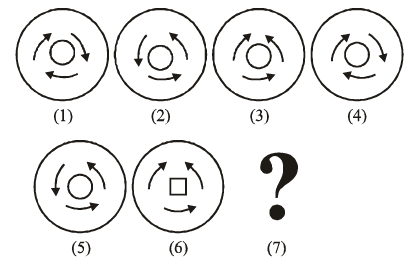
Which one of the following figures would logically come in the 7th position indicated above by a question mark? [2013 - II]
(a) 
(b) 
(c) 
(d) 
Correct Answer is Option (d)
From fig. (1) to (2), all arrows are moving clockwise direction. From fig. (2) to (3), all arrows are moving anti-clockwise direction. From (3) to (4), one arrow is in reversed direction and other are moving clockwise. Same pattern is followed for the rest.
Question 32: A cube has six numbers marked 1, 2, 3, 4, 5 and 6 on its faces. Three views of the cube are shown below: [2013 - II]
What possible numbers can exist on the two faces marked  respectively on the cube? [2013 - II]
respectively on the cube? [2013 - II]
(a) 2 and 3
(b) 6 and 1
(c) 1 and 4
(d) 3 and 1
Correct Answer is Option (a)
When we opened the cube
Now, (A) and (B), two possible number can exist on two faces are 2 and 3.
Question 33: Examine the following three figures in which the numbers follow a specific pattern:


The missing number (?) in the third figure above is [2013 - II]
(a) 7
(b) 16
(c) 21
(d) 28
Correct Answer is Option (b)
Observe the first two figures carefully :
Hence for the third figure,
⇒ x = 16
Question 34: Consider the following matrix:
What is the number at ‘X’ in the above matrix? [2013 - II]
(a) 5
(b) 8
(c) 9
(d) 11
Correct Answer is Option (c)
Consider 2nd element in each row. Sum up the digits of each number.
3 + 7 + 0 = 10
2 + 2 + 4 = 8
7 + 3 + 0 = 10
Now redraw the table agains:
∴ 1 + x = 10
⇒ x = 9
Question 35: DIRECTIONS: In each item, there are two sets of figures, first four figures named Problem figure sand next four figures named Answer figures indicated as (a), (b), (c) and (d). The problem figures follow a particular sequence. In accordance with the same, which one of the four answer figures should appear as the fifth figure?
Problem figures: [2013 - II]
Answer figures:
(a) 
(b) 
(c) 
(d) 
Correct Answer is Option (c)
In each step arrow symbol is inverting 180° and cross circle ⊗ symbol in each step touches one vertex of triangle in clockwise direction.
Hence, option (c) is the correct answer.
Question 36: DIRECTIONS: In each item, there are two sets of figures, first four figures named Problem figure sand next four figures named Answer figures indicated as (a), (b), (c) and (d). The problem figures follow a particular sequence. In accordance with the same, which one of the four answer figures should appear as the fifth figure?
Problem figures: [2013 - II]
Answer figures:
(a) 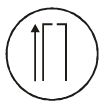
(b) 
(c) 
(d) 
Correct Answer is Option (b)
From figure (1) to (2), 2nd and 3rd design makes a pair and comes forward while 1st design gets 180° inverted. Same from figure (2) to (3) and figure (3) to (4).
Hence option (b) is correct answer.
Question 37: Consider the following figures 1, 2, 3 and 4:
In the figures from 1 to 4 above, two symbols are shown to change their position in a regular direction. Following the same sequence, which one of the following will appear at the fifth stage? [2013 - II]
(a) 
(b) 
(c) 
(d) 
Correct Answer is Option (b)
Below is the pattern followed by symbols.
Question 38: Examine the following statements:
1. Rama scored more than Rani
2. Rani scored less than Ratna
3. Ratna scored more than Rama
4. Padma scored more than Rama but less than Ratna.
Who scored the highest?
(a) Rama
(b) Padma
(c) Rani
(d) Ratna
Correct Answer is Option (d)
Ratna > Padma > Rama > Rani
So, Ratna scored the highest marks.
Question 39: In five flats, one above the other, live five professionals. The professor has to go up to meet his IAS officer friend. The doctor is equally friendly to all, and has to go up as frequently as go down. The engineer has to go up to meet his MLA friend above whose flat lives the professor's friend. From the ground floor to the top floor, in what order do the five professionals live? [2012 - II]
(a) Engineer, Professor, Doctor, IAS officer, MLA
(b) Professor, Engineer, Doctor, IAS officer, MLA
(c) IAS officer, Engineer, Doctor, Professor, MLA
(d) Professor, Engineer, Doctor, MLA, IAS officer
Correct Answer is Option (d)
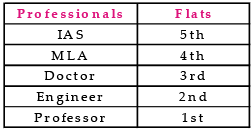
Question 40: Examine the following statements:
1. None but the rich can afford air-travel.
2. Some of those who travel by air become sick.
3. Some of those who become sick require treatment.
Which one of the following conclusions can be drawn from the above statements? [2012 - II]
(a) All the rich persons travel by air.
(b) Those who travel by air become sick.
(c) All the rich persons become sick.
(d) All those who travel by air are rich.
Correct Answer is Option (d)

